Updated: 20 May 2023
The following text gives a comprehensive overview of the dojo and the aikido we practise. It is aimed primarily at new members of the dojo, and is intended as a guide to help them get started in their daily aikido practice.
合氣道Aikido
Aikido is a Japanese martial art that Morihei Ueshiba developed at the beginning of the 20th century from ancient martial arts, especially sword fighting. In contrast to these martial arts, however, aikido serves exclusively peaceful purposes. Techniques that aim to injure are not taught. Morihei Ueshiba is called O-Sensei, "great teacher".
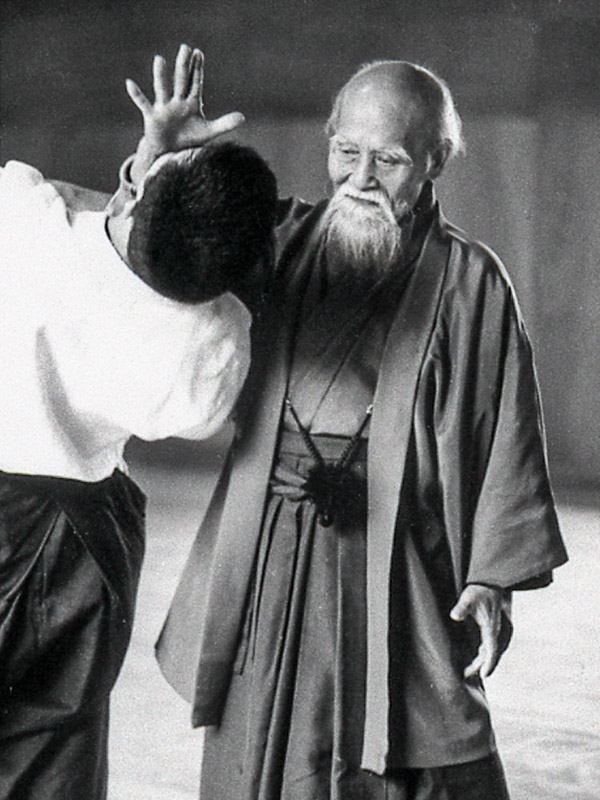
O-Sensei Morihei Ueshiba (1883-1969)
"Ai" stands for harmony, "ki" means energy, and "do" is the way. Aikido is therefore the way through which forces are harmonised. The basic principle is to work with the energy that the attacker brings and to add as little as possible. The dynamic and alert connection to the partner is always in the foreground.
The training place, but in a broader sense also the group that trains there, is called a "dojo". This is comparable to the term "club".
The main focus of the aikido training in our dojo is developing a good perception for the behaviour of our partners, practising adequate responses and building a self-confident presence. Awareness of the space, expansion of movement possibilities, rolling and falling, as well as breathing and posture exercises play a major role.
There are no competitions in aikido: it is a martial art, i.e. personal development is the main focus, not sport. Progress comes from regular practice and through the attendance of seminars and examinations.
Aikido can be practised regardless of gender, age and personal fitness. Aikidoka improve with each year of practice - many of the most respected teachers today are 50, 60, 70 years old or older.
As our regular classes are not taught in a course system, you may participate in any class independent of your experience. Beginners and advanced practitioners practice together, each on their own level.
The best way to get to know Aikido is to step on the mats: welcome to our dojo!.
 Our Dojo
Our Dojo
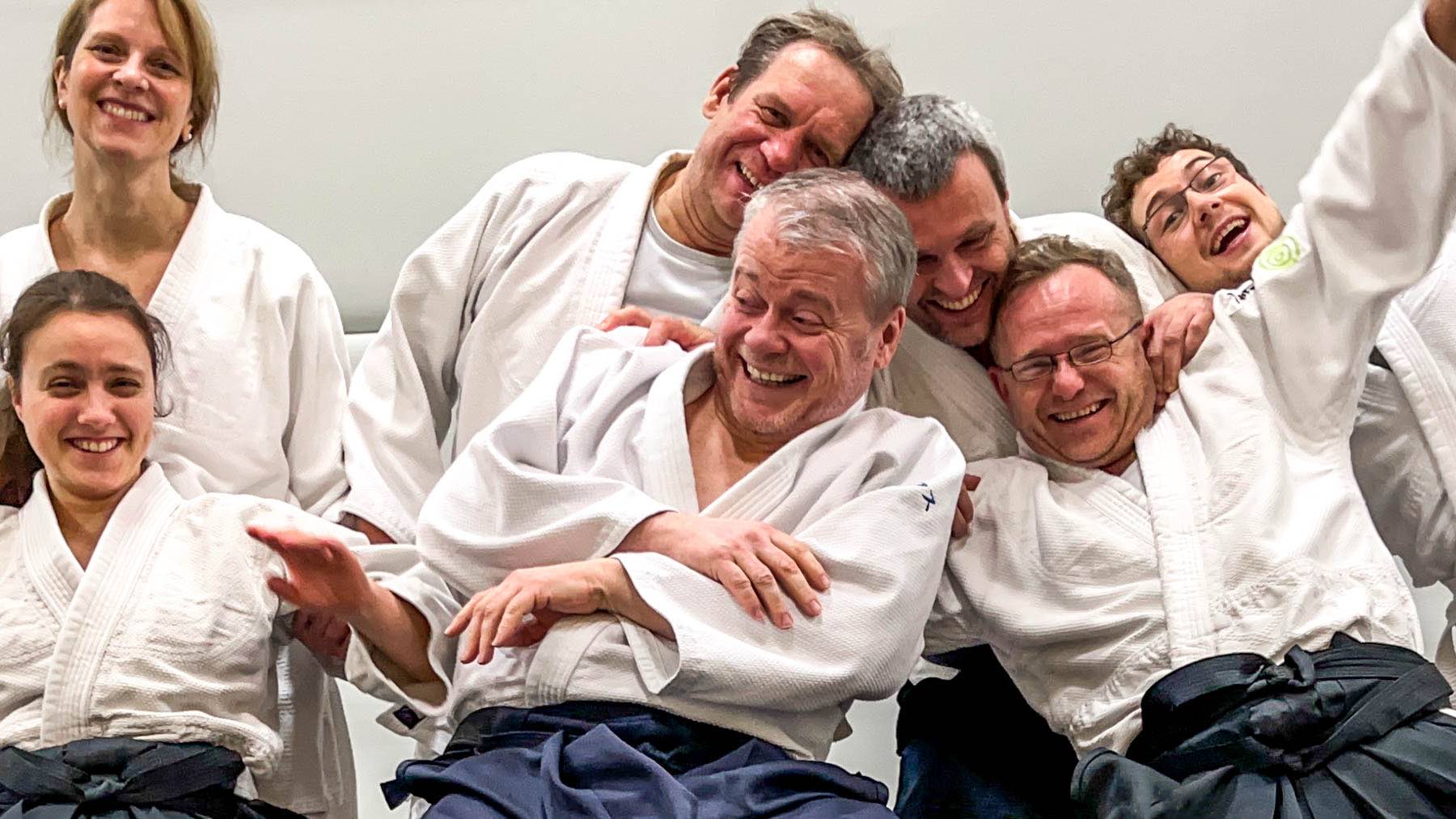
The Aikido Dojo Oberursel stands for a cosmopolitan, respectful and development-oriented aikido. We maintain close relationships and lively exchange with a number of international dojos. Therefore, we chose CONNECT ∙ EXCHANGE ∙ DEVELOP as our motto.
Our dojo was founded by Klaus Meßlinger in 2013, and inaugurated with a seminar held by Roberto Martucci (Kashin Dojo Rome). The first official class took place on 5 January 2014. Currently we have 57 members aged 14 to 74, of which 18 are women, and 39 men.
We take our inspiration from O-Sensei's student Yamaguchi Seigo shihan (1924-1996), and from his students Endo Seishiro shihan (Saku/Japan) and Christian Tissier shihan (Paris). Our direct teachers in this lineage are Jan Nevelius shihan and Jorma Lyly shihan (Vanadis Aikidoklubb Stockholm).
Our Values
Aikido is more than a martial art - it is a way of mastering life. The founder, O-Sensei Morihei Ueshiba, considered aikido a way of creating peace and making the world a better place:
- Take responsibility for your life
- Solve conflicts peacefully
- Build friendships all over the world
![Everybody is welcome! [Drawing of various stylised faces]](/images/ado/site/everybody_welcome_210x140_EN.png) Mutual respect is key for aikido practice. We are looking forward to practising with you, independent of your birthplace or the colour of your skin, of the language you speak and whether you are here permanently or just stay with us for some time, independent of your gender and of whom you love, independent of your age or personal history, independent of your religious or ideological views, independent of the size of your bank account or the number of degrees you have obtained, independent of whether you are in perfect physical and mental shape or deal with challenges - as long as we keep an open mind and treat each other with kindness and modesty.
Mutual respect is key for aikido practice. We are looking forward to practising with you, independent of your birthplace or the colour of your skin, of the language you speak and whether you are here permanently or just stay with us for some time, independent of your gender and of whom you love, independent of your age or personal history, independent of your religious or ideological views, independent of the size of your bank account or the number of degrees you have obtained, independent of whether you are in perfect physical and mental shape or deal with challenges - as long as we keep an open mind and treat each other with kindness and modesty.
We expect our dojo members to act responsibly, to refrain from premature generalisations, and to accept the possiblity that their own beliefs or skills may need adjustment. Without these character traits it is not possible to seriously practise aikido.
In aikido we practice in close physical proximity to each other, which is not easy for everyone, and we practice movements that can be very challenging at the beginning. Therefore, we make sure that we give our practice partners time to get used to the unfamiliar proximity and to work on the movements at their own speed. It goes without saying that we are mindful regarding what touches are perceived as appropriate by our partners.
The Logo
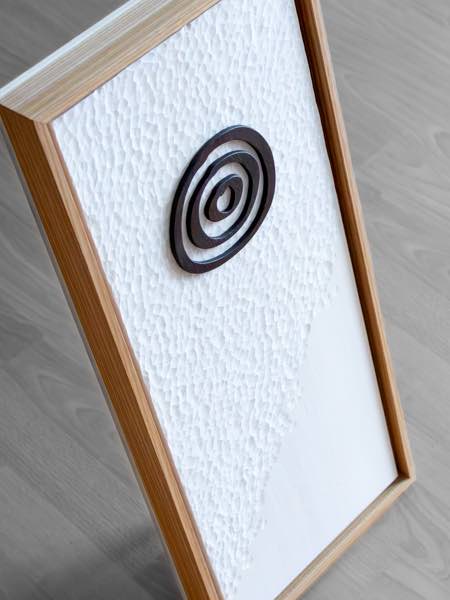
Stela with the dojo's logo
Our logo is made up of three concentric circles, drawn by hand with ink. The imperfection of the circles stands for the individual path every Aikido practitioner is following in the art. The logo stands for a number of ideas, in particular:
- Tree rings (growth and development)
- Wavelets caused by a drop in the lake (harmonic movement from silence)
- Contour lines of a mountain (perseverance and vision)
- Three reference points of techniques: centre, contact and distance
- A target symbolising concentration and focus on one task at a time
- Resting in oneself and simultaneously being aware of ambient space
- Three ensō symbols from Japanese calligraphy, expressing the moment when the mind is free to let the body create
- From inside out: Why? How? What? (Read Klaus Messlinger's personal answers)
Etiquette
As in other martial arts, there are rules of conduct in aikido. Their main purpose is to create an appreciative atmosphere and to prevent injuries. Focus, respect and politeness towards the training partners are at the core.
Attire and Hygiene
In aikido we wear plain white keikogis (also called aikidogi, dogi or gi; see our shopping tips). They consist of long white trousers, a jacket and a belt, and were originally underwear worn under the kimono. We recommend wearing additional normal underwear under the trousers. We also recommend wearing a plain coloured or white T-shirt under the jacket. If the jacket closes high on the neck, you can do without it.
In class, we practice barefoot in a confined space and at close proximity. Therefore, it is important to come to class in a clean keikogi and to avoid intrusive smells (cosmetics, garlic, etc.). Please wash yourself, in particular your feet and armpits, immediately before training; remove any makeup that might stain. Finger and toe nails are kept short to avoid injury. For the same reason, watches, rings, necklaces and protruding jewellery are removed. Before class, you must not drink alcohol or consume other substances that impair reactions. Please leave sufficient time between class and large meals.
Leave your street shoes in the changing room. In the dojo, slippers are worn whenever walking outside the mats. The mats are always entered barefoot. In exceptional cases, non-slip socks or tabi may be worn, e.g. in case of skin injuries.
Please take care that the mats are clean at all times: remove any stains immediately, using a soft cloth and cold water.
General Health & Hygiene Rules
Please follow these rules to ensure an enjoyable and safe practice environment:
- Shower or wash before class, in particular armpits and feet; remove makeup
- Always wear a freshly washed gi
- Remove your wristwatch and jewellery (rings, necklaces, earrings, etc.)
- Keep your finger and toe nails short
- Do not drink alcohol before class
- Give yourself enough time after larger meals before you enter the mats, and avoid garlic-flavoured foods on training days
- Should you need to catch your breath, inform your partner and take a rest by kneeling at the edge of the tatami.
- Should you feel that you cannot continue practising, let the teacher know before you leave the mat.
- Sneeze or cough into the inside of your keikogi, or use a handkerchief
- Do not touch your mouth, nose or eyes with your hands
- If you have cold symptoms: stay at home or leave the training immediately.
Order of Class / Bows
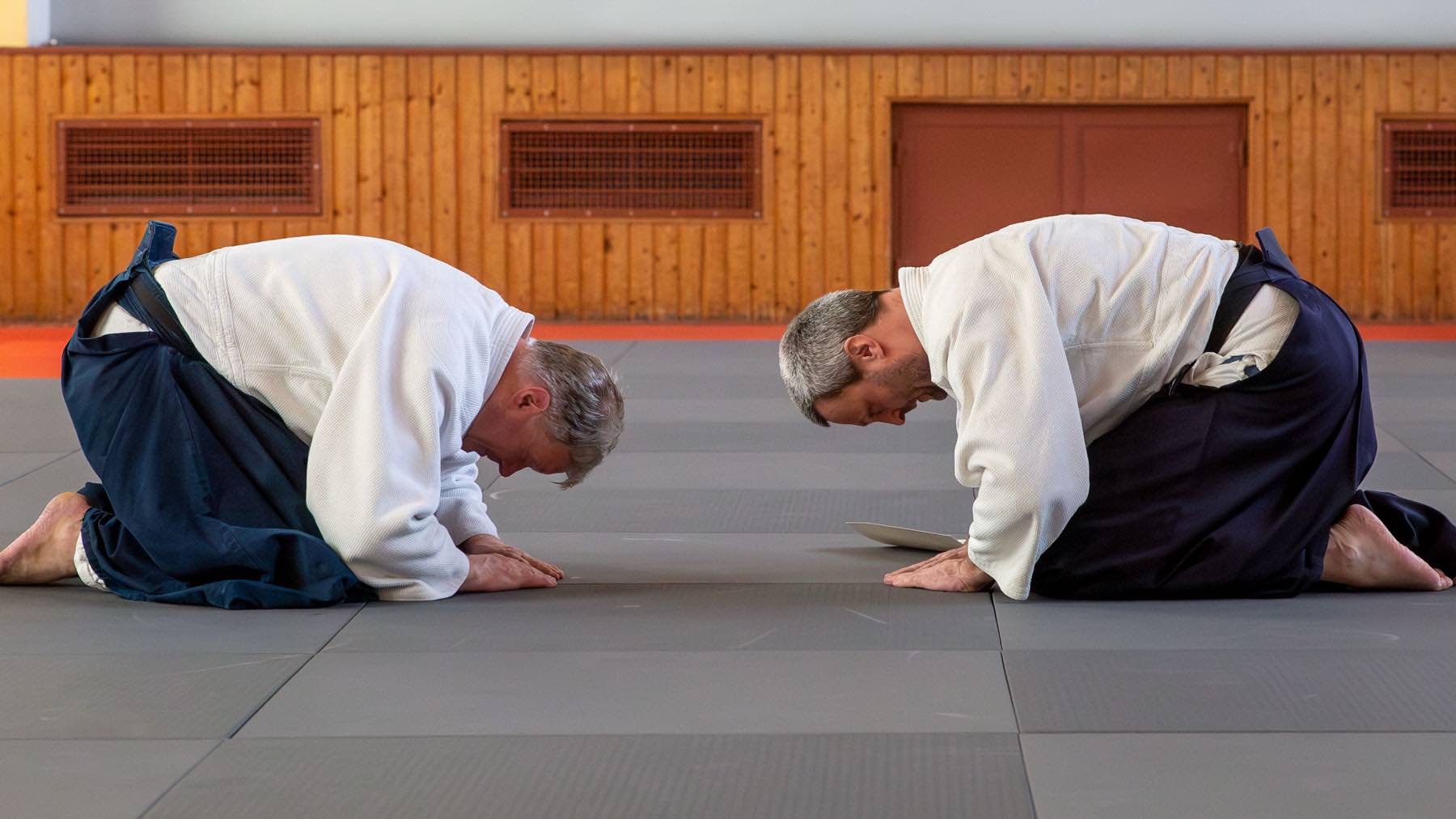
Bow after certificate hand-over
Participants should always arrive 15 minutes before class so that we can set up the mats together (at least 30 minutes before seminars). Please be on time, always.
On one long side of the mats there is a stela with an image (this can be calligraphy or a picture of O-Sensei). This stela marks the shomen, i.e. the "front" of the dojo. (Sometimes also called "Kamiza".)
In aikido we bow a lot, which can be confusing at first. Bows may seem like gestures of submission or reminiscent of religious rituals - but they are not. What is important is that you give each of these bows a meaning, a meaning for you personally. Then they will help you to make good progress in your personal development through the seriousness they express.
If mats and shomen have already been set up, we bow briefly on entering and leaving the room (standing, facing the shomen). This gesture represents the recognition that the dojo is a place with a special significance for our personal development.
The shomen is greeted before and after practice from a kneeling position. This bow is a sign of respect for aikido and at the same time an affirmation that you are leaving everyday life behind and concentrate on the upcoming practice. It is performed quietly and with focus, for about the duration of a conscious exhalation.
A second short bow to the centre of the mat is made to acknowledge the presence of the other participants. In this sole instance, those present do not return the bow.
At the beginning of class and during the explanations of the teacher, all participants kneel along the edge of the mats facing the shomen. At our dojo, there is no sitting order. To express our appreciation, we sit upright and attentive in a row without gaps. Leave enough space between you and your partners on the left and right so that you can bow without touching them.
After each explanation participants and teacher bow to each other. At the beginning and end of a partner session both partners bow to each other. In doing so, they express their respect and their will to treat each other with care.
All bows are performed calmly and attentively. When participants bow towards the teacher, they make sure that they come back up after the teacher.
Conduct in Class
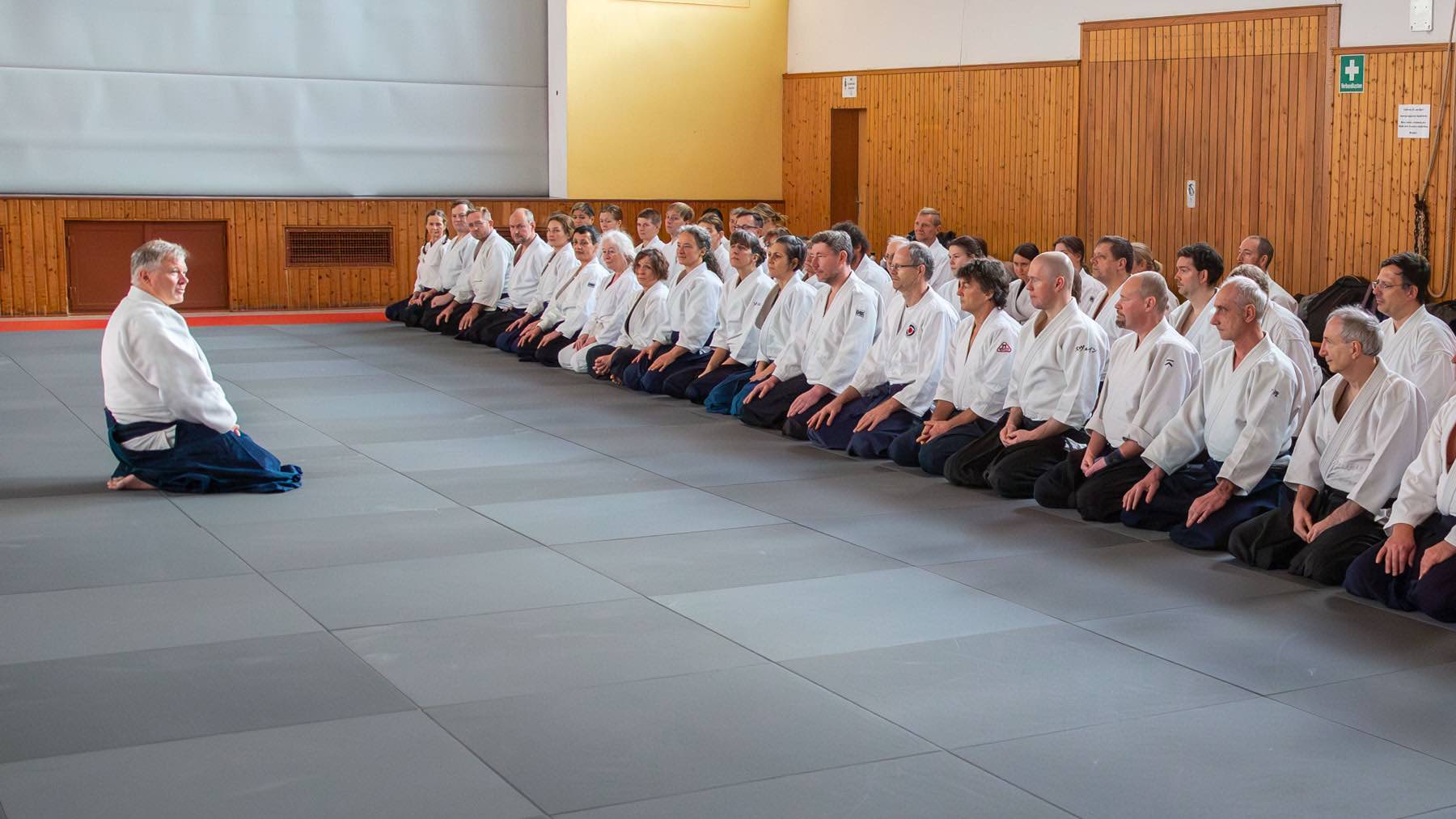
The partner exercises are performed with concentration, while simultaneously keeping an eye on the mat space around us and the other practitioners. In this way we ensure that we always have enough room for the intended exercise.
We refrain from loud talking, clapping or other loud noises.
Please call the teacher should you have any questions about the exercise. Never instruct your partners – it is an important part of personal development to be allowed to make mistakes. Instead, silently execute the best technique or attack you are capable of.
If your partner asks you a specific question, be brief with your answer or call the teacher for explanation.
Should a teacher call you out to support them as uke for a demonstration, respond with an audible "hai!". This helps the teacher to establish that you are available and prepared to come forward.
For each training round select a new partner, independent of the person's grade. Stay with them until the teacher starts a new training round or asks you to change partners. Your current partner/group always has your undivided attention.
If you are currently not active in the partner exercise, kneel at an appropriate distance and follow the proceedings attentively. You may kneel or sit cross-legged if you have knee issues; in both cases you keep an upright posture.
Please do not lean against a wall or cross your arms in front of your chest - this is considered very impolite, especially in classes with Japanese teachers. Do not sit with your legs outstretched towards the shomen, or with your back to it.
Teachers have the responsibility for the practitioners on the mats, so they always need to know who is present or missing. If you have to leave the mats, inform the teacher, in particular if it is because of an injury. If you are out of breath, excuse yourself to your partner and kneel at the edge of the mats to take a brief rest.
Should it happen that you are late for training, say "onegai shimasu" audibly from outside the mats. Wait for the teacher to respond before you enter the mats. Then you greet the shomen, do some warm-up and stretching exercises and join the training.
Aikidoka are on first-name terms, including towards teachers. We express respect for our partners through our behaviour, not through our form of address.
Only Japanese teachers are addressed as "sensei" instead of the name.
PS: Please take some time to read Sonja Sauer's excellent essay on uke etiquette (Sonja teaches at the "Aikido im Hof" dojo in Duisburg).
Japanese Terms
In class, we use many Japanese terms that are probably unfamiliar to you at first. Don't worry, you do not have to take a Japanese course, and you do not have to memorise everything right from the start.
Use our glossary to look up unfamiliar terms.
These are the most common terms:
- Aikido = the way (do) to harmonise (ai) the partners' energy (ki)
- Dojo = place of practice (room or house)
- Tatami = mat
- Shomen = front of the dojo, focus point (with picture); sometimes also called "kamiza"
- Keiko = class, training
- Onegai shimasu = a polite mutual "welcome" at the beginning of class; pronounced „onney-guy she-muss“
- Arigato gozaimashita = a polite mutual "thank you" at the end of class; pronounced „arigato gosai-mashta“
- Dozo! = please! (asking to start or continue something)
- Yame! = please stop! (prompt to stop current exercise)
- Owari masho! = let us finish! (prompt to finish class)
- Hai! = yes, OK, understood; here! (in reply to being called up)
- Uke = partner who is thrown or pinned down (attacker)
- Tori = partner who carries out the technique (defender); called "nage" in other dojos ("the one who throws")
Seminars
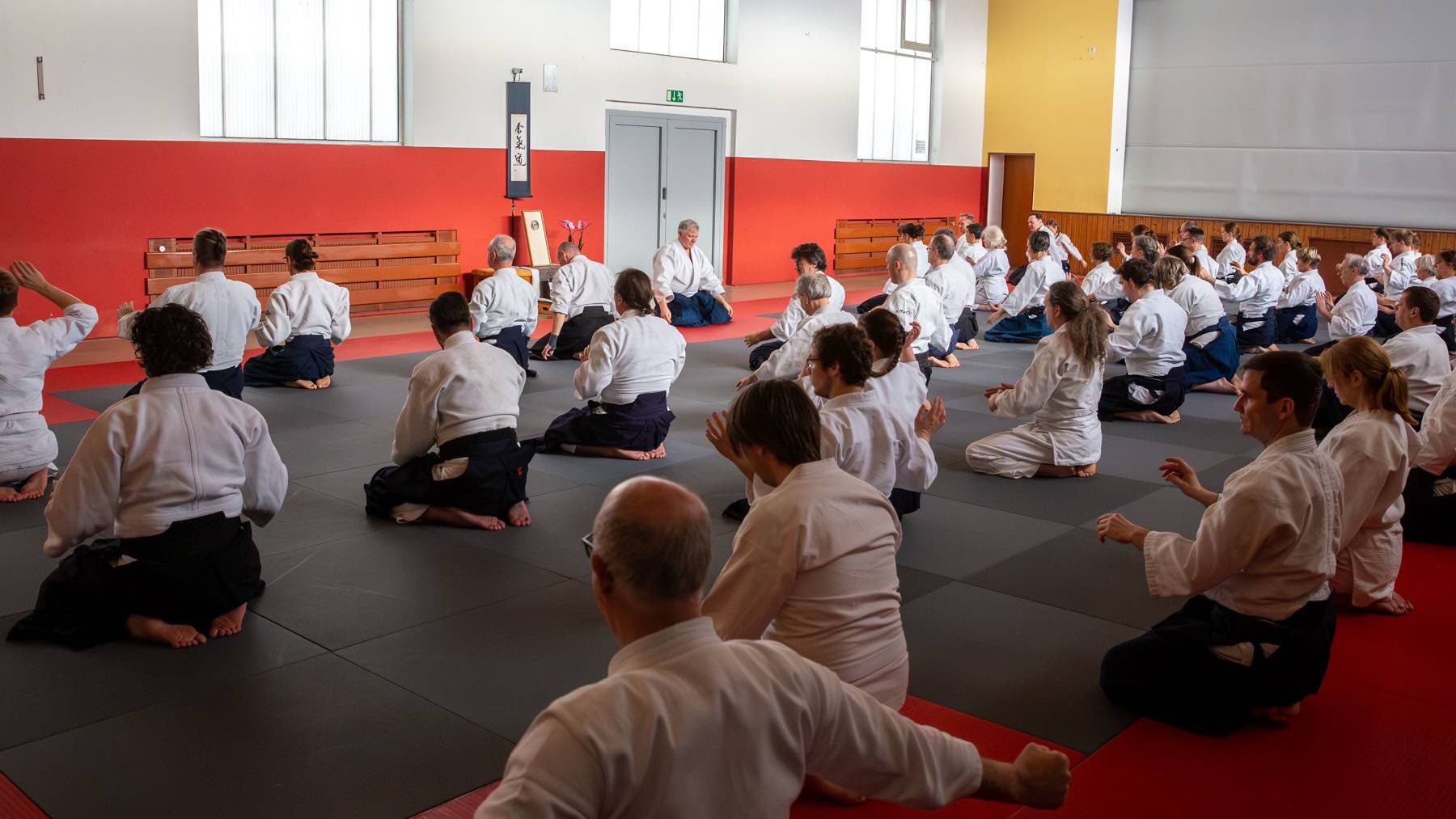
Seminar with Jan Nevelius shihan in Oberursel
The Aikido Dojo Oberursel maintains a lively exchange with teachers and dojos from all over the world. This community helps us with our development, promotes and supports the understanding of Aikido, and forms a large family of people who always enjoy meeting up.
We travel to a large number of seminars in Germany and abroad (mostly within Europe), and we invite teachers from all over the world to conduct seminars in Oberursel. Seminars are skill-building events that are open to practitioners of all levels (with very few exceptions). For advanced aikidoka, some seminars offer the possibility of taking black belt examinations, as at the dojo we only hold examinations for kyu grades (white belts).
All dojo members are encouraged to participate in as many of these events as possible, in particular if they take place in Oberursel. Participation in seminars leads to a noticeable boost in motivation and skills, triggered by the exchange with new partners and by new or differently conveyed teaching content.
Information on seminar etiquette can be found here.
Examinations
Gradings
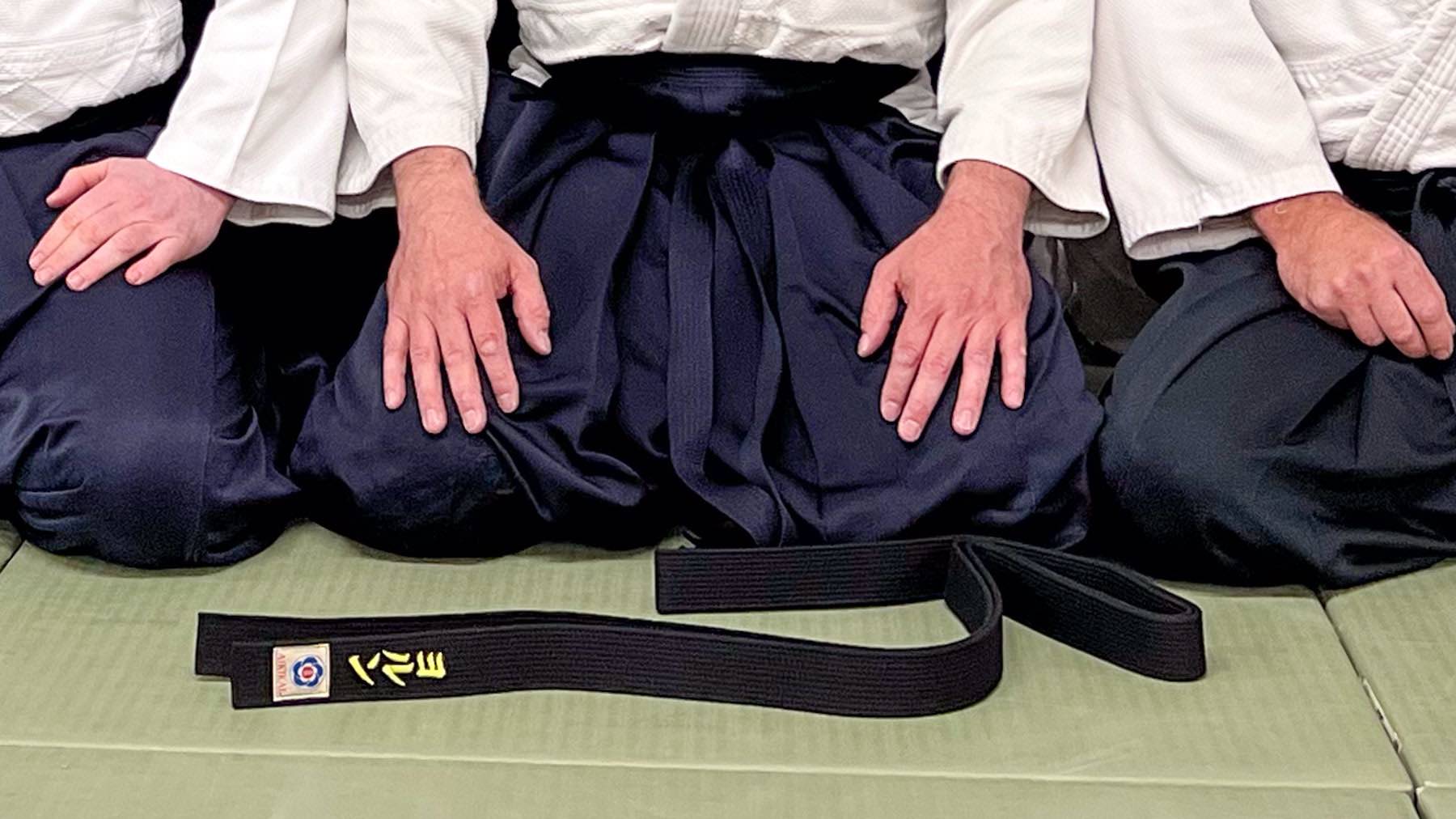
In Aikido, graduations (examinations) confirm the respective level of proficiency. Intensive preparation for exams makes it easier to internalise what has been learned and to achieve increasing familiarity with the techniques.
Kyu grades represent the training phase as students in Aikido which usually lasts between 5-7 years. Dan grades indicate advanced aikidoka who are often also active as teachers. In our line of aikido, all kyu grades have a white belt, while all dan grades wear a plain black belt.
The white belt grades are numbered in descending order from 6th to 1st kyu, which is the highest level.
From black belt onwards, the grades are counted upwards, i.e. 1st dan, 2nd dan, 3rd dan, etc. Here, examinations are usually only held up to 4th dan, higher grades are awarded.
From the 2nd kyu (second highest student grade) onwards, the practitioner wears a hakama. These skirt-like Japanese pants are usually black or dark blue, with the name embroidered in the Japanese syllabary katakana. The hakama identifies the wearer as an advanced aikidoka who has learned all the important techniques and knows how to take all kinds of ukemi. These aikidoka are also expected to behave in an exemplary manner and to take responsibility for tasks in the dojo.
Kyu gradings are conducted by our teachers in our own dojo. Dan examinations are usually conducted as part of international seminars. The preparation phase for the dan examination begins with the completion of the 2nd kyu. While our dojo members are essentially free to choose which teacher they want to be graded by we only prepare for gradings with Jan Nevelius shihan.
More information on dan examinations can be found here.
Training Periods and Requirements
The following training periods indicate the shortest possible time, before the next level can be taken. It is expected that the student attends classes two to three times a week during this period, especially in the last months before the exam.
- 6th kyu: after 3 months of practice
- 5th kyu: 6 months
- 4th kyu: 6 months
- 3rd kyu: 9 months
- 2nd kyu: 12 months, from age 16
- 1st kyu: 12 months
- 1st dan: 18 months, from age 18
Depending on the individual keiko intensity and progress, the actual training periods can also be shorter or (significantly) longer. For the kyu grades, the decision about admission to the examination lies with the head of the dojo. Longer waiting times are perfectly fine, because it is about your personal development, and the exams have to fit your life.
For each level we have a grading sheet that contains the required techniques and admission criteria, and another leaflet that describes the order of the examination (see our "Gradings" page).
We recognise any already existing grade held by new members. Grading to the next level, however, requires intensive training and a longer waiting period to meet the requirements of our examination syllabus. If new members hold a dan-level degree from outside the Aikikai Tokyo, further gradings may require additional steps.
Association with Federations
The Aikido Dojo Oberursel follows the guidelines of the international aikido umbrella organisation "Aikikai Tokyo", and is a member of the Aikido Föderation Deutschland national organisation, which is recognised by Aikikai Tokyo.
Our kyu examinations cover the requirements of these organisations. For dan examinations, we mainly prepare students for examinations conducted by Jan Nevelius Shihan. These examinations can be taken in Germany or Sweden, and they are recognised by Aikikai Tokyo.
Should a dojo member wish to take examinations with another shihan, or with a particular association, this will be respected. We do, however, recommend that you join the Aikido Föderation Deutschland.
The Club
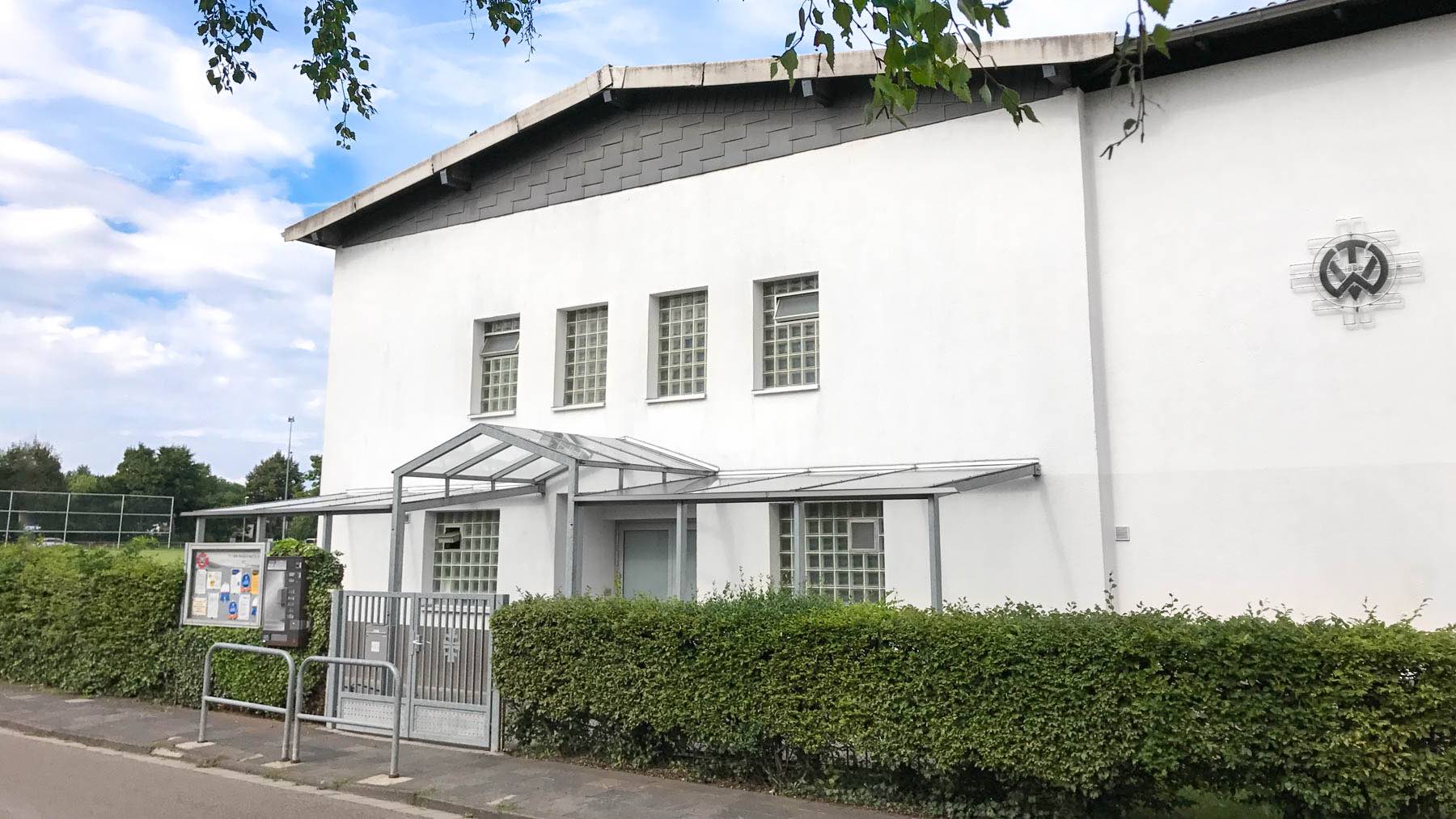
Club house of TVW sports club
The Aikido Dojo Oberursel is a department of the TV 1889 Weißkirchen sports club (TVW).
We founded the dojo as a department of a non-profit sports club to make it possible for as many people as possible to practise aikido. The TVW club is very dedicated to maintaining their building as a meeting place for the community. Voluntary work makes low fees possible, so that participation in training is not a question of income.
As a department, we support the club beyond our training schedule, e.g. by offering voluntary work for renovations and various events that finance the club.
The club's logo (see below) is based on the gymnasts' cross with four red Fs which represent the gymnasts movement's motto "frisch, fromm, fröhlich, frei" ("fresh, pious/hard-working, cheerful, free").
The club is ideologically and politically neutral.
Safe Environment
We attach great importance to all participants staying healthy and enjoying the practice in the dojo. Therefore, we are guided by our code of values and maintain an open and trusting relationship.
If you notice misconduct on the part of other participants or teachers, and you cannot resolve it in a direct conversation, please contact the head of the dojo. We take your concerns seriously and treat them confidentially.
If the misconduct concerns the head of the dojo, we ask you to speak to us and trust in our ability to accept criticism. Should this not be possible you may address the issue to the Leiter*in Sportbetrieb (head of sports) or – if it concerns minors – to the Kindeswohl-Beauftragte (child welfare commission) of the TV Weißkirchen sports club.


